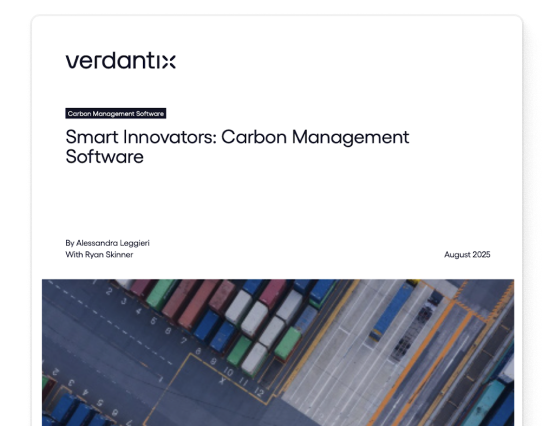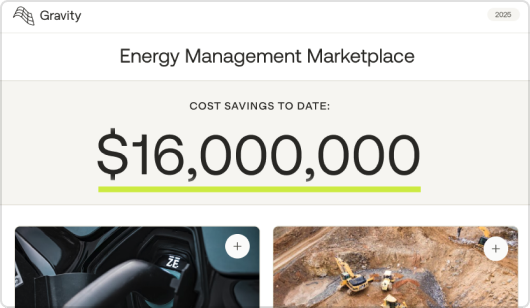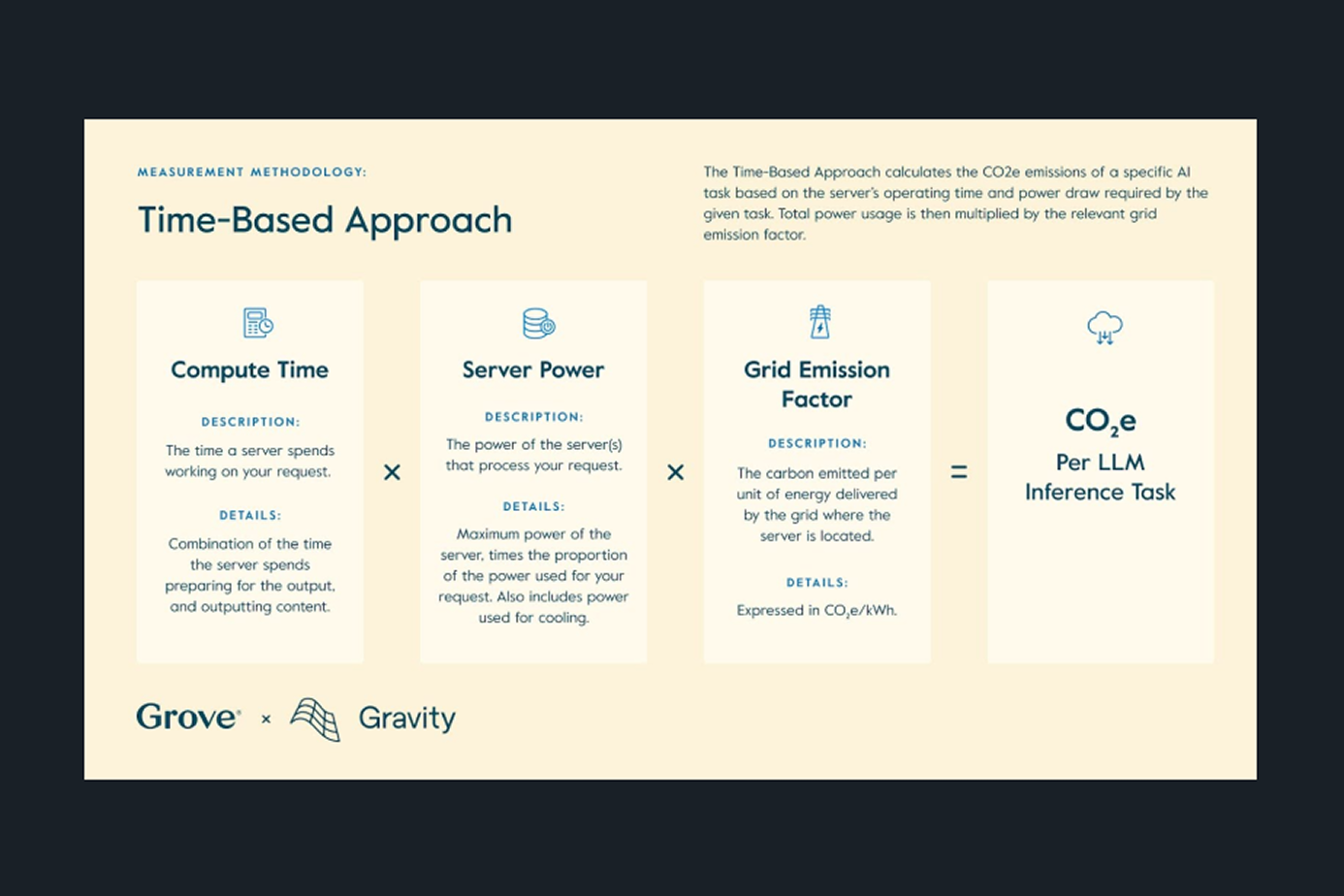See why customers are switching to Gravity
How to cost-effectively decarbonize your operations
With rising inflation and fears of a prolonged market downturn, businesses are looking to reduce costs wherever possible. Fortunately, cutting costs and cutting carbon don’t need to be conflicting goals. Thanks to rapid technological innovation, many decarbonization pathways are either cost neutral or cost-saving, meaning you don’t always have to choose between the two.

With rising inflation and fears of a prolonged market downturn, businesses are looking to reduce costs wherever possible. At the same time, many organizations are feeling increased urgency to manage their environmental impact, with over 60% of Fortune 500 companies declaring climate goals and over 13,000companies disclosing their annual emissions and climate risks.
The need for both cost-savings and climate action can leave business leaders feeling pulled in two directions. The squeeze is particularly acute in industrial sectors, where complex operations and tight margins are common.
Fortunately, cutting costs and cutting carbon don’t need to be conflicting goals. Thanks to rapid technological innovation, many decarbonization pathways are either cost neutral or cost-saving, meaning you don’t always have to choose between the two. Today, the three most promising levers for cutting costs while reducing emissions for industrial businesses are:
- Reducing fuel spend
- Improving energy efficiency
- Optimizing your supply chain.
With data-driven insights and sound strategy, organizations can thread the needle between both reduction areas – and create more resilient operations in the process.
Reduce Fuel Spend
Reducing fuel usage is a promising driver of both cost and emissions savings. For many industrial businesses, vehicle and equipment fuel are significant operating expenses. Burning fuel in internal combustion engines, generators, and other equipment also emits significant greenhouse gases.
One way to reduce fuel spend is to limit fleet idling. Not all idling is avoidable, but a report from the North American Council for Freight Efficiency estimates that most fleets can reduce idling by 20%. Depending on the size of your fleet, that could result in significant fuel and emissions savings – even six or seven figures.
Another way to reduce costs and emissions is to electrify your fleet. Especially as gas prices increase, switching to electric vehicles has become not only cost-competitive, but also cost-reductive. Thanks to lower maintenance needs, an electric vehicle’s average operational cost is about half that of a vehicle with an internal combustion engine. Even after accounting for increased electricity usage for charging (more on that below), using EVs reduces your carbon footprint.
Beyond vehicles, some industrial processes that rely on combustive machinery can also be electrified, leading to similar fuel and emissions savings. Producing heat in industrial settings often requires burning fossil fuels, which can be a big cost and emissions center. Fortunately, innovations in electrically-powered boiler, furnace, and heat pump technologies have put significant reductions within reach – equivalent to 2.7 million cars’ worth of greenhouse gases annually. McKinsey estimates that around half of industrial equipment fuel usage could be reduced by leveraging currently available electrification solutions.
Improve Energy Efficiency
Energy efficiency represents another promising area to reduce both emissions and costs. With electricity costs likely to rise for the foreseeable future, improving your organization’s energy efficiency can not only reduce your Scope 2 emissions, it can reduce a growing cost liability, too.
There are many tried-and-true ways to reduce electricity demand, from switching to efficient LED light bulbs to installing smart thermostats and lighting systems. If your electricity needs span multiple sources, you might consider optimizing usage through “demand flexibility.” With this approach, organizations stagger electricity-powered operations around the clock to minimize on-peak charges, which can account for up to 60% of total electricity costs.
Smoothing energy usage creates immediate cost-savings by reducing on-peak charges. It also makes it easier for electricity grids to transition to a more renewable fuel mix when generating electricity, ultimately lowering everyone’s emissions per kilowatt hour purchased.
Organizations can take a more proactive approach to emissions reductions by switching to renewables themselves. Renewable sources like solar and onshore wind have dropped precipitously in price. Electricity produced from solar is now the “cheapest electricity in history” in most major countries, according to analysis by the International Energy Agency. Purchasing renewable electricity also helps ensure that increased electricity needs from vehicle electrification don’t displace emissions in one category for equivalent emissions in another.
Gravity works with a manufacturer that installed a solar array on the roof of their main factory, generating all the electricity in the renewable manner and removing a significant line-item cost. In states with net metering laws, businesses can earn additional revenue by selling unused electricity back to the grid.
Optimize Your Supply Chain
For almost all organizations, the emissions associated with supply chain partners – your Scope 3 emissions – comprise the vast majority of your total carbon footprint. Getting visibility into your Scope 3 emissions hotspots and cost drivers can yield powerful insights to cut both costs and carbon.
One area to focus on is procurement, which is typically in your direct control. The most straightforward way to reduce both costs and emissions associated with procurement is to purchase less material for a given product. This can be done by enhancing product-line efficiency or committing to reusing scraps. Separately, companies can consider sourcing raw materials that are cost-competitive with current suppliers (green aluminum is one example). Purchasing less or different materials doesn’t necessarily require redesigning a product. But the design phase presents another opportunity for cost-savings and decarbonization.
In particular, companies in the consumer packaged goods (CPG) sector have been pioneering synergies between climate action and cost-consciousness. For example, Unilever committed to reduce the downstream consumer emissions footprint of its products by 50% by 2030. Some consumer-facing companies have agreed to subsidize emissions reductions within their upstream suppliers. For example, over 4,500 suppliers have partners with Walmart on Project Gigaton. Organizations at all levels of the supply chain to follow a similar playbook.
In today’s challenging environment, businesses confront pressures to reduce both costs and carbon emissions. Areas including fuel spend, energy efficiency, and the supply chain present opportunities to accomplish both goals. Gravity equips businesses with the insights they need to evaluate these win-win scenarios — reach out to see how.
Download the report to learn more
VerdantixTM Smart Innovators: Carbon Management Software

Curious about Gravity's Energy Management Marketplace?
Book a demo to learn more

Curious about Gravity's Europe expansion?
Book a demo to learn more
.png)
Ready to get off the merry-go-round?
Book a demo to learn more.

Curious about Gravity's CDP accreditation?
Book a demo to learn more.

California's Carbon Reporting Rule
Watch our webinar to prepare for California's new climate regulation

Curious about these features?
Book a demo to learn more.

Be prepared for SECR
Meet with our team, walk through the steps you'll need to take to report, and start a free trial to see how Gravity can help you report with greater speed and accuracy.

See the platform in action
Watch a short video to see why leaders like WM, TTI, and WAF have chosen to work with Gravity to simplify carbon accounting and drive business impact.

Meet with our team, walk through the steps you'll need to take to report, and start a free trial to see how Gravity can help you report with greater speed and accuracy.

Cut down reporting time by 70%
Request a demo to see these features in action and learn how they can save hours of manpower in your next reporting cycle.
Looking to Uplevel Your Sustainability Programs in 2025?
Reach out for a personalized meeting with our climate experts to find opportunities to save time on regulatory compliance, simplify internal communications, and execute projects that deliver real business impact.
Find energy efficiency projects that deliver value
Learn how to reduce energy costs and emissions.

Be prepared for the CSRD
Get in touch to find out how your company should prepare for the CSRD amidst changes to the regulation.




%20(1).png)